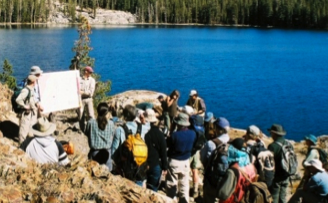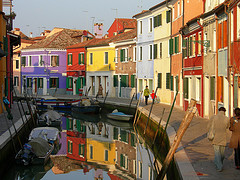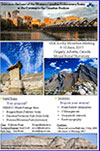- Your First Listen
- Listen Live
- Recently Played
- On-Air Highlights
- Carlin & Brent
- Your Toronto
- Pop Culture
- Job Opportunities
- Contest Rules & Regs
- Privacy Policy
- Accessibility


FIELD TRIP 2017
Field Trip has announced the lineup for its 2017 festival and its a return to its roots for the festival which takes place at Fort York June 3 and 4.
The annual two-day festival put on by Arts & Crafts, now in its fifth year welcomes back Broken Social Scene and Feist as headliners, with Phoenix and A Tribe Called Red joining the bill as well.
The festival will feature a range of artists for its fifth year, with local favourites Hannah Georgas , BADBADNOTGOOD , and Timber Timbre all set to perform. They’ll be joined by some heavy-hitting international artists such as The Pharcyde , James Vincent McMorrow , Thundercat , Cloud Nothings , Portugal. The Man , Tei Shi , Joseph , and more.
Check the full lineup below!

All general admission and VIP single day & weekend tickets are on sale now at fieldtriplife.com .
WEEKEND PASSES * GA WEEKEND (2 DAY) PASSES ARE $125. * VIP WEEKEND (2 DAY) passes are $200.
SINGLE DAY PASSES * GA SINGLE DAY PASSES ARE $80. * VIP SINGLE DAY PASSES ARE $130. * All tickets are subject to a facility fee and vendor service charges. * Children 12 years and under are admitted FREE with an adult ticket holder. Maximum of two children per adult. * GA tickets will also be available at Toronto independent music retailers Soundscapes and Rotate This. * Payment plans will be available for all ticket types and price points.
- endless-scroll
RELATED ARTICLES
Dine alone records summer flea event, indie88’s close encounter with k. flay, indie88 and collective arts present outside the box with dizzy, most popular, indie88’s festive festival fest, indie88’s 10k fridays, win tickets to alvvays, stop by the sorauren park farmers market for your fresh goods.
Indie88 (CIND-FM) is Toronto’s New Alternative. Launched on August 3rd, 2013, as Canada’s first indie music station, Indie88 provides a platform for emerging artists while paying homage to the classics that inspired them. Indie88 is where new music belongs. It’s also a multi-media hub for news, local lifestyle, and pop-culture content focused on unique and engaging stories.
Contact us: [email protected]
© Indie88


FIELD TRIP 2017: A Guide to This Year’s 5 Best Family-Friendly Bands
Field Trip’s Day Camp will once again offer a variety of programming perfectly suited to little ones that will also give their parents a chance to take a break from the 26 acts that will perform on two stages.
Over the course of five years, Field Trip has set itself apart from many of the summer music festivals by providing family-friendly programming. It’s been said that Toronto’s hipsters are getting older and instilling their love of music in their kids. Field Trip’s Day Camp will once again offer a variety of programming perfectly suited to little ones that will also give their parents a chance to take a break from the 26 acts that will perform on two stages.
PureGrainAudio came up with a list of the five best family-friendly acts that will perform at Fort York and Garrison Common on June 3 and 4.
01. The Fuddles – The Fuddles will feature a familiar face for fans of Toronto’s vibrant indie music scene. Scott Kaija (controller.controller) combined his two great loves; indie rock and entertaining children. He also performs as Hiccup the Clown . Kaija teamed up with fellow musicians Daniel Brooks and John Hunter , each of them cultivating their own unique look, character and stage name; Scotty, Dee and Jay. They write lighthearted songs about sharing and kindness aimed squarely at preschool and grade school kids.
02. The Monkey Bunch – Much like many animated features and series are made so kids and parents and kids can enjoy them, The Monkey Bunch take the same approach to music; crafting quality music that kids will love and won’t drive parents crazy. The band creates music that doesn’t talk down to kids.
03. Space Chums – Many of the acts on Field Trip have a definite theatrical feel to their music and Space Chums promise the same for the little ones at the event. Describing themselves as They Might Be Giants , The Bee Gees and The Muppet Show inside the Large Hadron Collider , their show promises singing, dancing, audience participation and improvisation that they promise will draw a crowd.
Asa Berezny from KoB has toured with the Hidden Cameras and shared the stage at Massey Hall with Ron Sexsmith and fellow Field Trip performer Feist . Brighid Fry has been dubbed “Toronto’s tween queen of rock ‘n roll.”
05. shy kids – In keeping with the spirit of music that kids and parents can enjoy, shy kids will play a set of kids’ favourites and pop covers.
In addition to music that kids and their parents can enjoy, Field Trip 2017 will also feature Bubbleology , an interactive performance about blowing giant bubbles, Heath Tarlin ‘s Spin Cycle , a show featuring juggling and unicycles and Unity Charity ‘s Hip Hop Arts Program , a showcase for aspiring rappers, beatboxers and dancers. For a complete line-up of children’s music and programming at Field Trip , please visit: www.fieldtriplife.com .
Check out a teaser video for Field Trip 2017
CBC Music Festival 2017 @ Echo Beach (Toronto, ON) on May 27, 2017 [Show Review]
WHITE NOISE RADIO Reach the ‘Cosmos’ with Stream for New Single “Dawning”
You may like

Sasquatch Spotted in Calgary. Here’s Proof!
Enjoy 24 Bands at Electric Highway Festival for Only 75 Bucks!
The Electric Highway Fest Drops 2023 Spotify Playlist

Ziigwan Indigenous Music and Arts Festival Coming to Toronto in March
The Electric Highway Fest Returns to Calgary in March 2023!

Le Phoque OFF Festival Unveils Entire Eclectic 2023 Lineup

Tom Walker Puts on Spellbinding Performance at Leeds O2 Academy

The Cruel Knives Headline Top Night of British Rock at Manchester’s The Lodge [Photos]

Formz: “I was always the confident kid in school, with a passion for entertaining and being the centre of attention..”

In Flames, Gatecreeper & Creeping Death Pummel Hampton Beach Casino Ballroom [Photos]

JD Pinkus Drops “I Would Like To Pet It” off Upcoming ‘Grow a Pair’ LP

Fair Visions Unveil Their New LP ‘Quite An End’

The V13 Fix #013 w/ Six Feet Under, The Days, BlackGold and more
The V13 Fix #012 w/ Dååth, Unearthly Rites, maybeshewill and more

Ice Cube Discusses His Canadian Tour, Growing Up in South Central, and the Need for Feel-Good Music

Kill The Lights Michael ‘Moose’ Thomas Talks Success, International Bandmates and more

Rob Lundberg’s “Uncontaminated Sound – The Interviews” EP #67 w/ Joshua Farinella of The Whistleblower

The Field Trip (2017)
Full cast & crew.

Directed by
Writing credits (in alphabetical order) , cast , cinematography by , sound department .
Release Dates | Official Sites | Company Credits | Filming & Production | Technical Specs
Contribute to This Page
- Full Cast and Crew
- Release Dates
- Official Sites
- Company Credits
- Filming & Production
- Technical Specs
- Plot Summary
- Plot Keywords
- Parents Guide
Did You Know?
- Crazy Credits
- Alternate Versions
- Connections
- Soundtracks
Photo & Video
- Photo Gallery
- Trailers and Videos
- User Reviews
- User Ratings
- External Reviews
- Metacritic Reviews
Related Items
- External Sites
Recently Viewed

An official website of the United States government
Here’s how you know
Official websites use .gov A .gov website belongs to an official government organization in the United States.
Secure .gov websites use HTTPS A lock ( Lock A locked padlock ) or https:// means you’ve safely connected to the .gov website. Share sensitive information only on official, secure websites.

Overview for geologic field-trip guides to Mount Mazama, Crater Lake Caldera, and Newberry Volcano, Oregon
- Document: Report (5.25 MB pdf)
- Scientific Investigations Report 2017-5022-J1 - Chapter J1: Geologic field trip guide to Mount Mazama and Crater Lake Caldera, Oregon
- Scientific Investigations Report 2017-5022-J2 - Chapter J2: Field-trip guide to the geologic highlights of Newberry Volcano, Oregon
- Larger Work: This publication is Chapter J of Field-trip guides to selected volcanoes and volcanic landscapes of the western United States
- Download citation as: RIS | Dublin Core
These field-trip guides were written for the occasion of the International Association of Volcanology and Chemistry of the Earth’s Interior (IAVCEI) quadrennial scientific assembly in Portland, Oregon, in August 2017. The guide to Mount Mazama and Crater Lake caldera is an updated and expanded version of the guide (Bacon, 1989) for part of an earlier IAVCEI trip to the southern Cascade Range. The guide to Newberry Volcano describes the stops included in the 2017 field trip. Crater Lake and Newberry are the two best-preserved and most recent calderas in the Cascades Volcanic Arc. Although located in different settings in the arc, with Crater Lake on the arc axis and Newberry in the rear-arc, both volcanoes are located at the intersection of the arc and the northwest corner region of the extensional Basin and Range Province.
Suggested Citation
Bacon, C.R., Donnelly-Nolan, J.M., Jensen, R.A., and Wright, H.M., 2017, Overview for Geologic Field-Trip Guides to Mount Mazama, Crater Lake Caldera, and Newberry Volcano, Oregon: U.S. Geological Survey Scientific Investigations Report 2017–5022–J, 3 p., https://doi.org/10.3133/sir20175022J.
ISSN: 2328-0328 (online)
Table of Contents
- Contributing Authors
- Overview for Geologic Field-Trip Guides to Mount Mazama, Crater Lake Caldera, and Newberry Volcano, Oregon
- References Cited
Center for Teaching
Teaching outside the classroom.
Teaching and learning experiences that take place outside of the confines of the classroom walls have a range of benefits for both students and instructors. When students are asked to put into practice “in the real world” what they have theorized about from behind a desk, the result is a student-centric learning experience that enhances learning and fosters personal and social development (Larsen, Walsh, Almond, & Myers, 2017). Further, students that engage in learning experiences outside of the classroom report having higher levels of motivation, recall the course material more vividly, and have improved academic performance in the class (Takeuchi et al., 2016; Ryan and Deci, 2017). Moreover, field experiences early in a student’s career can be formative and can inspire students to continue in a field (e.g., Hutson, Cooper, & Talbert, 2011).
Learning experiences outside the classroom are forms of experiential learning (Dewey, 1897). These experiences are rooted in the simple principle that “experience is the best teacher.” Under this framework, learning outside of the classroom is an active process, wherein students encounter authentic problems, construct novel hypotheses, test for real solutions, and interact with others to make sense of the world around them. When we do this, we encounter the world as a whole and are forced to engage multiple modalities, no matter which pair of disciplinary “lenses” we intended to wear. Because experiential learning is inherently interdisciplinary, scientists and humanists alike would do well to consider the ways in which other disciplines might enrich their own disciplinary approach to their field.
There are many ways to make learning extend outside the classroom:

- Field Trips
Study Abroad
General strategies for successful field trip and field-based learning experiences, technology outside (and inside) the classroom, assessment of field experiences.
- Additional Resources for Research on Experiential Learning
Field Trips and Field-Based Learning

Field trips may be defined as “any journey taken under the auspices of the school for educational purposes” (Sorrentino & Bell, 1970, p. 223). Along with the engagement of concepts that is required by these experiences, the student bonding that occurs on field trips enhances the learning experience and creates a learning community as students continue onward in a discipline. Teaching in the field also gives instructors the opportunity to get to know their students in greater depth in terms of how the students see the world differently than the instructor. This insight into student world-views can help the instructor to better communicate the concepts of the course.
Field trips can take a variety of forms that meet a diverse set of needs and can enhance deep, active learning. The intended educational outcomes of field trips focus on the following five areas (Behrendt & Franklin, 2014; Larsen et al., 2017; Tal & Morag, 2009):
- Developing social and personal skills
- Developing observation and perception skills
- Adding relevance and meaning to learning
- Providing first-hand real-world experiences
- Enhancing intrinsic motivation and interest in the subject
Field trips are a common component of many K-12 classrooms, with a wealth of reviews in the primary literature summarizing their benefits and best practices (e.g., Behrendt & Franklin, 2014; DeWitt & Storksdieck, 2008; Wilson, 2011). In the college classroom, field trips (or field-based learning ) can be an effective tool that satisfies many of the above goals. For some disciplines (e.g., geology, ecology) it is relatively easy to imagine what a field-based learning experience can look like, whereas for other disciplines (e.g., philosophy, English), it may not be immediately obvious. To help instructors begin to imagine the possibilities that could exist in their courses, Fedesco, Cavin and Henares (in press) recently used a database of 721 field trips from 2015-2018 at a small, private, liberal arts college in the Southwest to create a typology of field study experiences in higher education. The authors identified the following types of field-based learning experiences:
- Collecting primary data/visiting primary sources – Students and instructors gather data in a novel setting, with open-ended and unpredictable learning outcomes for students depending on the results of that data. Being immersed within the subject material allows for deep learning for students, as they experience the authenticity of data collection and the process of interpreting that data. Instructors should be flexible and prepared to navigate difficult and/or unproductive outcomes – such as if the data don’t reveal anything significant (or present a result that is counter to the instructor’s initial predictions). However, these experiences have the highest potential for learning for students, as they are in a sense creating new knowledge.
- Guided discovery of a site – The class visits a site that is familiar to the instructor but new to the students and the instructor plans an activity that leads the students to uncover an intended outcome. Students should use the skills and concepts they learned in an earlier portion of the course and apply them in a novel setting to help guide learning. Instructors should consider how their materials and questions will help students develop higher-order skills, such as investigating, questioning, and developing critical thinking skills. Because they are time-consuming and require a significant investment from the instructor, they are best used to teach conceptually difficult or especially important course material. For more information on preparing and facilitating guided discovery problems in your classroom, see the guide on the National Association of Geoscience Teachers website .
- Backstage access – The class is granted access to a site or a place that the general public does not have access to, thus giving a unique experience to the students that allows for insights and experiences that are difficult to come by normally. For an on-campus example, a class might visit a University research lab or center that is available only to students registered in a course (such as the Breazeale Nuclear Reactor at Penn State ). For off-campus examples, students might visit a net-zero residence, tour behind the scenes of a government building, or meet with employees of a local company. These experiences may require an initial contact with a community partner or a prior-established relationship; however, the learning outcomes for students are enormous, and some companies may be willing to work with classes as the experience offers a networking opportunity for both students and potential employers.
- Show and tell – The class is given access to a third-party expert or a site where they might hear from the expert, such as in the collections of a museum with a curator. Like backstage access, this represents an opportunity for students to have an experience that is not available to the general public and can thus result in deep learning and foster meaningful connections for students. This also helps the instructor cover subject material with which they may not be intimately knowledgeable. However, instructors should have a role in planning with the third-party expert to ensure active engagement from their students; otherwise, you run the risk of students sitting or standing for long periods of time for an uninspiring lecture.
- Place-based immersion – The class spends a significant amount of time in a place, investigating either a specific subject or an entire breadth of subjects tied to that place. Places have both natural and cultural histories, which therefore lend themselves to examination by all disciplines. Field experiences and research are at the core of many of the natural and social sciences. In the humanities, field experiences might be working in archives, collecting oral histories, performing one’s art for a public audience, but it could also include visiting important historical sites and place-based experiences including using places for inspiration.
- Community engagement – Professors and students engage in a partnership with a local organization or institution over the span of the course or travel to a site to do time-bound projects, often with a significant investment from the students. These projects, typically designed by both faculty and community partners, allow for students to learn in highly effective ways while helping a community address its needs. In all of these experiences, student growth can be extensive, whether it is through improved critical thinking and problem-solving skills, greater personal efficacy and leadership development, or enhanced social responsibility and career opportunities. For more information on the benefits and methods of these pedagogies, as well as step-by-step guides to successful service learning courses, please visit the CFT’s Service Learning and Community Engagement teaching guide and the Community Engaged Teaching Step by Step teaching guide .
- Retreats – The class gets away to a remote site for as little as a day or as much as a week to bond, to focus on the subject or a special project, and/or to write. The retreat can be combined with the benefits of place-based immersion, although there need not be a reason for the class visiting a specific site. The main objective of a retreat is to garner the benefits of students spending focused time in close proximity together and away from the hustle and bustle of normal college life. Some outdoor learning experiences, due to their length, are by definition retreats: for example, geologic field trips; wilderness literature backpacking trips; and study abroad experiences.
- Special Events – The class travels to a conference or a special event (e.g., a speaker on campus, a film, a performance, etc.) that is pertinent to the course content or objectives. The instructor has little control over what is said during the event and thus should feel comfortable giving up the reins for this experience. A degree of flexibility for the instructor and maturity on the students’ parts will help these events fit within the framework of the class schedule. Instructors should be prepared to give a pre-event lesson and a post-event lesson to help ensure students meet the intended learning outcomes.
Benefits for Students Who Participate in These Experiences Include:
- knowledge transfer and knowledge recall (Nadelson & Jordan, 2012)
- increased relevance, improved perspective-taking, and increased autonomy (Lai, 1999)
- increased interest in the subject and influence on one’s college major and future career (Hutson et al., 2011)
- improvement in concept knowledge (Elkins & Elkins, 2007)
- improvements in understanding course content, performance on course assignments, and interest in the subject (Goh & Ritchie, 2011).
- increased relatedness with instructors and peers, competence, autonomy, and intrinsic motivation in the course (Fedesco et al., in press)
Key Factors That Promote Successful Experiences Include:
- See the section below titled “General Strategies for Successful Field Trip and Field-based Learning Experiences”
Additional Resources:
- National Association for Geoscience Teachers (NAGT) guides for Teaching in the Field and Safety in the Field
- Special Issue of Journal of Geoscience Education on Teaching in the Field
- Searchable collection of references and resources on field-based learning from the Synthesis of Research on Learning in the Geosciences by the Science Education Resource Center
- “ Field Notes ” by David W. Mogk, Dept. of Earth Sciences, Montana State University: Research based methods for successful field trips, including specific examples for a geoscience course
- The Out-of-Classroom Experience by Dave Douglass: A comprehensive article on things to consider when “dreaming-up, organizing, planning and leading field trips and other learning activities that will take place outside of the traditional classroom setting”
- Vanderbilt Release form for student field trips

There are several models for study-abroad programs. In some, participants enroll in foreign universities as visiting, non-matriculated students. In other programs, the sending institution retains more control over the curriculum, duration, faculty selection, and experience. Increasingly, schools are internationalizing their curriculum by offering short-term, faculty-led, study abroad programs. Vanderbilt’s Global Education Office administers many programs available for students to study abroad.
Benefits for Students Who Participate in These Programs Include:
- increase in student willingness to take courses outside of their major
- increased confidence to travel abroad in longer-term programs
- increased interest in interdisciplinary studies
- increased skills of inter-cultural communication
- greater international or comparative understandings of social issues
- a more sophisticated understanding of global social change
- greater understanding of inequalities and differences in the world system
Key Factors That Promote Successful Programs Include:
- academic rigor
- use of mixed teaching methods
- facilitated reflection synthesizing experiences with academic content
According to Lori Gardinier and Dawn Colquitt-Anderson, “There is no formula for the percentage of time that should be spent in formal class time, seeing cultural/historical sites and events, doing field work, or engaging in peer-to-peer cultural exchange. Regardless of the mix, students should arrive at the destination with a grounding in both the academic and cultural context through a combination of pre-departure lectures, guided research, online discussions, readings, and cultural events relevant to the trip.” (26)
In study abroad situations, faculty leaders assume a number of roles that extend beyond the classroom, and setting appropriate boundaries becomes critical. It can be helpful to set specific parameters for how, when, and where you will relate to students during the program.
It is important to identify risks and liability. Directors must be prepared for expected emergencies involving lost or stolen property, illnesses, and so on, as well as unexpected emergencies involving natural and manmade disasters.
- The Institute of International Education Founded in 1919, the Institute of International Education (IIE) is a private nonprofit leader in the international exchange of people and ideas. In collaboration with governments, foundations and other sponsors, IIE creates programs of study and training for students, educators and professionals from all sectors. These programs include the flagship Fulbright Program and Gilman Scholarships administered for the U.S. Department of State. IIE also conducts policy research, provides resources on international exchange opportunities and offers support to scholars in danger.
- The National Association of International Educators (NAFSA) NAFSA and its members believe that international education and exchange—connecting students, scholars, educators, and citizens across borders—is fundamental to establishing mutual understanding among nations, preparing the next generation with vital cross-cultural and global skills, and creating the conditions for a more peaceful world.
- Journal of Studies in International Education The Journal of Studies in International Education (JSI) is a forum for higher education administrators, educators, researchers and policy makers interested in research, reviews, and case studies on all facets of the internationalization of higher education. Each issue brings together the concepts, strategies, and approaches of internationalization, the internationalization of the curriculum, and issues surrounding international students and cross-border delivery of education.

Tips and Techniques:
These tips were provided by VU faculty experienced in taking students on field trips.
- Set up the field trip as a research project that includes data collection.
- Conduct a theoretical examination of the issue in class long before going into the field. Students should have a sense of what the field trip is going to be about before they go.
- At least two weeks before heading into the field, develop the rudiments of basic hypotheses. At this point the instructor should give details about the field site so that students know what to expect.
- In the field, focus on the things that you’ve agreed to focus on and let the other stuff be icing on the cake.
- Take a backpack full of extra warm/dry clothes and snacks to pass out to students as the need arises.
- If for a large class, prepare TAs well to manage smaller groups of the class.
- Prepare students for practicalities including appropriate attire, expectations for physical exertion, anticipated rest stops, supplies and materials they should bring.
Additionally, Fedesco et al. (in press) has identified five specific tips to help educators have a successful field-based learning experience:
- Begin the trip with a full value contract (FVC). The FVC is a document written for the group, by the group, and establishes agreed upon expectations on what is appropriate or inappropriate behavior on the trip. This document, which can be updated as needed, can be referred to throughout the trip, and provides a sense of safety and community for the class.
- Logistics play an important role in the success of a field trip. If students are lacking in basic human needs (e.g., uncomfortable temperatures, hungry/thirsty, standing in direct sunlight, exhaustion), they will be less likely to learn. Check the weather forecast and have students plan accordingly. Make sure you have plenty of food to eat throughout the day, and be mindful of food allergies and preferences to ensure a smooth experience.
- Carefully consider the sequence of events during a field trip. Outdoor education expert Jay Roberts (2016) recommends that mornings are better for intellectual topics, afternoons are better for hands-on activities, and evenings are best for reflection and interpersonal discussions.
- Balanced programming should be taken into consideration when planning field trips. Instructors should avoid over- or under-programming trips, which could lead to either information saturation or boredom. Instructors should continuously take the pulse of the experience so if necessary, they can implement their contingency plan by either cutting back on some activities or incorporating more experiences or assignments into the trip.
- Instructors about to embark on a field trip should be prepared to engage in risk management behavior. Before leaving for a trip, instructors should be familiar with and have contact information for emergency resources in the field location, campus security, administration, transportation, and mental health and sexual assault counselors.
Advances in technology make it relatively easy for students to bring digital technology with them when they leave the classroom, or for instructors to bring the outdoor learning environment into the classroom. In the field, students can use mobile devices—including ones they already own—to engage in learning activities. In the classroom, instructors can use drone footage, mobile apps, and programs like Google Earth to bring outdoor environments inside, thus bringing far-away or inaccessible outdoor phenomena to all students. Below are some examples to help you start thinking about how you might use technology outside (and inside!) your classroom.
Location-Specific Content
With the right apps, students can access content that is tied to a particular location and only available when students visit that location.
- Spanish instructors at the University of New Mexico use an iPhone app from the Augmented Reality and Interactive Storytelling (ARIS) project to send students on a fictional murder mystery through the Los Griegos neighborhood in Albuquerque that develops and tests their language skills. Students receive location-specific clues to the mystery by typing their location into the app.
- The Iowa City UNESCO City of Literature iPhone app provides text, audio, and video content about Iowa City authors based on the user’s GPS-determined location. Instructors at the University of Iowa plan to have students use this app to learn more about Iowa City authors and their connections to particular local environments.
- CFT director Derek Bruff incorporated QR codes in an end-of-semester “crypto hunt” in his first-year seminar on cryptography. Students cracked codes and ciphers that led them to particular locations on campus featuring QR codes, two-dimensional bar codes that students scanned with their smart phones to receive additional clues in the hunt.
- Instructors can also have students create location-specific content. For example, students at the University of Northern Colorado created a scavenger hunt designed to teach other students about local water rights using the ARIS platform.
Data Collection and Sharing
Mobile devices have a variety of mechanisms for collecting and sharing data. Students can use these devices to generate location-specific content whether on a field trip or on their own.
- Shaul Kelner, associate professor of sociology and Jewish studies at Vanderbilt, taught a course titled “Tourism, Culture, and Place” in the spring 2011 semester. Students in the course visited different tourist sites around Nashville, captured photos of these locations using their cell phones while on-site, and then blogged about their visits and their photos later.
- Margaret Rubega, associate professor of ecology and evolutionary biology at the University of Connecticut, requires students in her ornithology course to use the social media service Twitter to “tweet” about the birds they see as they go about their lives–what birds they see, where they see them, and any connections to course content that occur to the students. They tag their tweets with the hashtag #BirdClass to make it easy for all involved to find and read each other’s tweets.
- Lawrence University students in an introduction to environmental science course collect geotagged water quality data during field trips using GPS devices and tablet PCs. Students pool their data, then analyze it using geospatial visualization software while still in the field. Many such specialized data collection and analysis tools are developing mobile apps that run on iPhones and other smart phones.
If you’re interested in using technology in the field in your courses, please contact the CFT’s educational technologist Rhett McDaniel for help getting started.
- Rubrics developed by the Associate of American Colleges & Universities (AAC&U) including some on civic knowledge and engagement, teamwork, problem solving, integrative and applied learning.
- Reflection papers
- Lab reports
- Suggestions for assessment of field courses by the National Association of Geoscience Teachers
Additional Resource for Research on Experiential Learning
- National Society for Experiential Education (NSEE)
Behrendt, M., & Franklin, T. (2014). A review of research on school field trips and their value in education. International Journal of Environmental and Science Education , 9 , 235-245. http://doi.org/10.12973/ijese.2014.213a
Dewey, J. (1897). My pedagogic creed . New York: E. L. Kellogg & Co.
DeWitt, J. & Storksdieck, M. (2008) A short review of school field trips: Key findings from the past and implications for the future. Visitor Studies, 11 , 181-197, http://doi.org/ 10.1080/10645570802355562
Elkins, J. T., & Elkins, N. M. (2007). Teaching geology in the field: Significant geoscience concept gains in entirely field-based introductory geology courses. Journal of Geoscience Education , 55 , 126-132. http://doi.org/10.5408/1089-9995-55.2.126
Fedesco, H. N., Cavin, D., & Henares, R. (in press). Field-based learning in higher education: Exploring the benefits and possibilities. Journal of the Scholarship of Teaching and Learning.
Gardinier, L. & Colquitt‐Anderson, D. (2010). Learning abroad. New Directions for Teaching and Learning, 2010, 23-29, http://doi.org/ 10.1002/tl.417
Goh, E. & Ritchie, B. (2011) Using the Theory of Planned Behavior to understand student attitudes and constraints toward attending field trips. Journal of Teaching in Travel & Tourism, 11 , 179-194. http://doi.org/10.1080/15313220.2011.575024
Hutson, T., Cooper, S., & Talbert, T. (2011). Describing connections between science content and future careers: Implementing Texas curriculum for rural at-risk high school students using purposefully-designed field trips. Rural Educator , 33 , 37-47.
Lai, K. C. (1999). Freedom to learn: A study of the experiences of secondary school teachers and students in a geography field trip. International Research in Geographical and Environmental Education , 8 , 239-255. http://doi.org/10.1080/10382049908667614
Acknowledgements
1 This guide was originally written in 2010 by Lily Claiborne and John Morrell (Graduate Teaching Fellows) and Joe Bandy and Derek Bruff (CFT Assistant Directors). It was updated in 2020 by Gregory Smith (Graduate Teaching Fellow) and Heather Fedesco (CFT Assistant Director) to include primary literature research in higher education that has come out since the original iteration.

Teaching Guides
- Online Course Development Resources
- Principles & Frameworks
- Pedagogies & Strategies
- Reflecting & Assessing
- Challenges & Opportunities
- Populations & Contexts
Quick Links
- Services for Departments and Schools
- Examples of Online Instructional Modules
FIELD TRIP RECORDINGS

Reimaging Culture & Music
Fueled by passion and the desire to reimagine what it means to be a music company., ssgkobe x lyrical lemonade x field trip records, calabasas ft. $not, latest releases., listen to our artist's latest collections..

MALLORY MERY

Artist-First Mentality.
Founded in 2018, Field Trip Records is uniquely positioned within culture to propel talent.
Los Angeles, CA

Want to work with us? Reach out!
READ ABOUT FIELD TRIP RECORDINGS.
Building the coolest record label in the world.

Photo by Julian Berman
COOL HUNTING
From creating playlists to seeking out the next big artists, a pioneering path in the music industry.

Photo by nextsubject.
© Field Trip Records 2022 | All Rights Reserved. Conjunction of culture and artistic talent. Based in Los Angeles.
Archive of All Online GSA Field Guides:
1999–present.
- Volume 67 (2024): Geology and Geologic Hazards of the Blue Ridge: Field Excursions for the 2024 GSA Southeastern Section Meeting, Asheville, North Carolina, US
- Volume 66 (2023): Field Excursions to the Appalachian Plateaus and the Valley and Ridge for GSA Connects 2023
- Volume 65 (2023): Field Excursions to the Northern Sierra Nevada of California, the Mining Districts of the Sierra Nevada, and Cretaceous and Paleocene Sediments in Maryland, USA
- Volume 64 (2022): Field Excursions in the Front Range and Wet Mountains of Colorado for GSA Connects 2022
- Volume 63 (2022): Field Excursions from Las Vegas, Nevada: Guides to the 2022 GSA Cordilleran and Rocky Mountain Joint Section Meeting
- Volume 62 (2021): From Terranes to Terrains: Geologic Field Guides on the Construction and Destruction of the Pacific Northwest
- Volume 61 (2021): Field Excursions from the 2021 GSA Section Meetings
- Volume 60 (2021): GSA in the Field in 2020
- Volume 59 (2020): From the Islands to the Mountains: A 2020 View of Geologic Excursions in Southern California
- Volume 58 (2020): Architecture and Evolution of the Crust during Continental Arc Magmatism: A Transect through the Coast Mountains Batholith, British Columbia
- Volume 57 (2020): Geology Field Trips in and around the U.S. Capital
- Volume 56 (2019): The Gigantic Markagunt and Sevier Gravity Slides Resulting from Mid-Cenozoic Catastrophic Mega-Scale Failure of the Marysvale Volcanic Field, Utah, USA
- Volume 55 (2019): Geologic Excursions in Southwestern North America
- Volume 54 (2019): Iceland: The Formation and Evolution of a Young, Dynamic, Volcanic Island—A Field Trip Guide
- Volume 53 (2019): Field Excursions in the Carolinas: Guides to the 2019 GSA Southeastern Section Meeting
- Volume 52 (2019): Exploring Extreme and Unusual Geology in the Stable Midcontinent: Field Excursions for the 2019 GSA South-Central, North-Central, and Rocky Mountain Sections Joint Meeting
- Volume 51 (2018): Ancient Oceans, Orogenic Uplifts, and Glacial Ice: Geologic Crossroads in America's Heartland
- Volume 50 (2018): Geology at Every Scale: Field Excursions for the 2018 GSA Southeastern Section Meeting in Knoxville, Tennessee
- Volume 49 (2017): From the Puget Lowland to East of the Cascade Range: Geologic Excursions in the Pacific Northwest
- Volume 48 (2017): Geologic Field Trips of the Canadian Rockies: 2017 Meeting of the GSA Rocky Mountain Section
- Volume 47 (2017): From the Blue Ridge to the Beach: Geological Field Excursions across Virginia
- Volume 46 (2017): Forts, Floods, and Periglacial Features: Exploring the Pittsburgh Low Plateau and Upper Youghiogheny Basin
- Volume 45 (2017): Field Excursions in Southern California: Field Guides to the 2016 GSA Cordilleran Section Meeting
- Volume 44 (2016): Unfolding the Geology of the West
- Volume 43 (2016): Geology of the Baraboo, Wisconsin, Area
- Volume 42 (2016): Gold, Structures, and Landforms in Central South Carolina—Field Guides for the 2016 GSA Southeastern Section Meeting, Columbia, South Carolina
- Volume 41 (2016): Exploring the Geology of the Inland Northwest
- Volume 40 (2015): Tripping from the Fall Line: Field Excursions for the GSA Annual Meeting, Baltimore, 2015
- Volume 39 (2015): Diverse Excursions in the Southeast: Paleozoic to Present
- Volume 38 (2014): Trials and Tribulations of Life on an Active Subduction Zone: Field Trips in and around Vancouver, Canada
- Volume 37 (2014): Exploring the Northern Rocky Mountains
- Volume 36 (2014): Geologic Field Trips along the Boundary between the Central Lowlands and Great Plains: 2014 Meeting of the GSA North-Central Section
- Volume 35 (2014): Elevating Geoscience in the Southeastern United States: New Ideas about Old Terranes—Field Guides for the GSA Southeastern Section Meeting, Blacksburg, Virginia, 2014
- Volume 34 (2014): Formation of the Sierra Nevada Batholith: Magmatic and Tectonic Processes and Their Tempos
- Volume 33 (2013): Classic Concepts and New Directions: Exploring 125 Years of GSA Discoveries in the Rocky Mountain Region
- Volume 32 (2013): Geologic Excursions from Fresno, California, and the Central Valley: A Tour of California's Iconic Geology
- Volume 31 (2013): Insights into the Michigan Basin: Salt Deposits, Impact Structure, Youngest Basin Bedrock, Glacial Geomorphology, Dune Complexes, and Coastal Bluff Stability
- Volume 30 (2013): Late Cretaceous to Quaternary Strata and Fossils of Texas: Field Excursions Celebrating 125 Years of GSA and Texas Geology, GSA South-Central Section Meeting, Austin, Texas, April 2013
- Volume 29 (2012): From the Blue Ridge to the Coastal Plain: Field Excursions in the Southeastern United States
- Volume 28 (2012): Deformation, Fluid Flow, and Mass Transfer in the Forearc of Convergent Margins: Field Guides to the Northern Apennines in Emilia and in the Apuan Alps (Italy)
- Volume 27 (2012): On and around the Cincinnati Arch and Niagara Escarpment: Geological Field Trips in Ohio and Kentucky for the GSA North-Central Section Meeting, Dayton, Ohio, 2012
- Volume 26 (2012): Neoproterozoic Glacial and Associated Facies in the Tanafjord-Varangerfjord Area, Finnmark, North Norway
- Volume 25 (2012): The Southern Cordillera and Beyond
- Volume 24 (2011): Archean to Anthropocene: Field Guides to the Geology of the Mid-Continent of North America
- Volume 23 (2011): Field Guide to Samos and the Menderes Massif: Along-Strike Variations in the Mediterranean Tethyan Orogen
- Volume 22 (2011): Geological Field Trips in Central Western Europe: Fragile Earth International Conference, Munich, September 2011
- Volume 21 (2011): Geologic Field Trips to the Basin and Range, Rocky Mountains, Snake River Plain, and Terranes of the U.S. Cordillera
- Volume 20 (2011): From the Shield to the Sea: Geological Field Trips from the 2011 Joint Meeting of the GSA Northeastern and North-Central Sections
- Volume 19 (2011): Structural Geology and Tectonic Evolution of the Sognefjord Transect, Caledonian Orogen, Southern Norway—A Field Trip Guide
- Volume 18 (2010): Through the Generations: Geologic and Anthropogenic Field Excursions in the Rocky Mountains from Modern to Ancient
- Volume 17 (2010): From Precambrian Rift Volcanoes to the Mississippian Shelf Margin: Geological Field Excursions in the Ozark Mountains
- Volume 16 (2010): The Mid-Atlantic Shore to the Appalachian Highlands: Field Trip Guidebook for the 2010 Joint Meeting of the Northeastern and Southeastern GSA Sections
- Volume 15 (2009): Volcanoes to Vineyards: Geologic Field Trips through the Dynamic Landscape of the Pacific Northwest
- Volume 14 (2008): Geological Society of America Field Guide 14, 2008 Joint Annual Meeting, Houston, Texas, 5–9 October 2008
- Volume 13 (2008): Field Trip Guides to the Backbone of the Americas in the Southern and Central Andes: Ridge Collision, Shallow Subduction, and Plateau Uplift
- Volume 12 (2008): From the Cincinnati Arch to the Illinois Basin: Geological Field Excursions along the Ohio River Valley
- Volume 11 (2008): Field Guide to Plutons, Volcanoes, Faults, Reefs, Dinosaurs, and Possible Glaciation in Selected Areas of Arizona, California, and Nevada
- Volume 10 (2008): Roaming the Rocky Mountains and Environs: Geological Field Trips
- Volume 9 (2007): Floods, Faults, and Fire: Geological Field Trips in Washington State and Southwest British Columbia
- Volume 8 (2006): Excursions in Geology and History: Field Trips in the Middle Atlantic States
- Volume 7 (2006): 1906 San Francisco Earthquake GSA Field Guides
- Volume 6 (2005): Interior Western United States
- Volume 5 (2004): Field Trips in the Southern Rocky Mountains, USA
- Volume 4 (2003): Western Cordillera and Adjacent Areas
- Volume 3 (2002): Science at the Highest Level
- Volume 2 (2000): Great Basin and Sierra Nevada
- Volume 1 (1999): Colorado and Adjacent Areas
Affiliations
- Join the Society
- Publisher Bookstore
- Publisher Homepage
- Contact the Society
- Open Access Policy
- Copyright © 2024
- How to Subscribe
- Privacy Policy
- For Librarians
- For Industry
- For Society Members
- For Authors
- Terms & Conditions
- 1750 Tysons Boulevard, Suite 1500
- McLean, VA 22102
- Telephone: 1-800-341-1851
- Copyright © 2024 GeoScienceWorld

This Feature Is Available To Subscribers Only
Sign In or Create an Account
- Utility Menu
Environmental Science & Public Policy
Field trips.

PAST FIELD TRIPS
Summer 2017: China’s Environmental Challenges: Summer Course in Beijing
In August 2017 thirty Harvard students participated in "China’s Environmental Challenges: Summer Course in Beijing," a two-week intensive summer program on China's environmental challenges. This program, sponsored by the the Harvard-China Project and the ESPP program, offered students a unique chance to explore various environmental and climate change issues in China, including clean energy, air pollution, waste water management, and urban sustainability, through: site visits to clean tech companies, water and power facilities, and a government climate institute; guest talks by local environmental actors; and academic lectures and discussions led by Tsinghua and Harvard faculty.
-----------------------------------------------------------------------------------------------------------------
Winter 2015: Sevilleta Field Station, New Mexico
Graduate School of Design professor Richard Forman led the January 2015 trip to the Sevilleta Field Station, operated by the University of New Mexico and located in central New Mexico (60 miles south of Albuquerque). Concentrators spent a week exploring the diverse ecological and biological landscape of the American Southwest. The station lies at the junction of several major ecosystems, and researchers have access to a broad diversity of habitats, including the Chihuanhuan Desert grasslands and shrublands; Colorado Plateau shrub-steppe; juniper savanna; the riparian Rio Grande corridor; and more.
Winter 2014: Archbold Biological Station, Florida
In January 2014 concentrators traveled to the Archbold Biological Station, located seven miles south of Lake Placid, Florida, for a week of ecological studies on human-imprinted areas and land-use planning. Led by Professor Richard Forman and Professor James McCarthy, the students visited a variety of habitats; evaluated competing land uses; and developed a land-use plan for a changing Highlands County, Florida landscape, which was later presented to a group of local townspeople.
----------------------------------------------------------------------------------------------------------------- Winter 2013: Sailing School vessel Corwith Cramer, Florida
In January 2013 Concentrators were given the opportunity to spend J-Term aboard the Sailing School vessel Corwith Cramer, operated by the Sea Education Association (SEA) in Woods Hole. Participants met the ship in Key West, Florida and sailed across the Gulf Stream and back to Key West. During their experience, students took advantage of the state-of-the-art research tools, processing oceanographic samples, standing round-the-clock shifts and delving into navigation, science, and becoming members of the crew. All costs of the trip (including roundtrip transportation from Boston to Key West) were covered. Please see the slideshow above for photos from the experience.
- Concentration Requirements
- Declaring ESPP as your Concentration
- Senior Thesis
- ESPP Secondary Field
- Energy & Environment Secondary Field
- Search Please fill out this field.
- Manage Your Subscription
- Give a Gift Subscription
- Newsletters
- Sweepstakes
- Hotels + Resorts
13 Best U.S. Resorts for Reconnecting With Nature — Hot Springs, Hiking Trails, and Open-air Massages Included
From Alaska to Maine, these U.S. nature resorts beautifully combine wilderness and wellness.
Stephanie Vermillion is a travel journalist and photographer covering culture and adventure for Travel + Leisure Outside, and more.
:max_bytes(150000):strip_icc():format(webp)/Stephanie-Vermillion-author-pic-936a16f1e2994cb3a3421e722bb0e770.jpg)
Few things reduce stress like quality time in the great outdoors, but getting into nature doesn't require far-flung treks or bare-bones camping. Nature resorts across the U.S. pair wilderness with a touch of pampering — think on-site hot springs after a day of desert exploration and open-air massages to recover from long hikes on the trails.
If the coast, desert, or mountains are calling, these splendid wilderness-focused resorts could be the answer. Each getaway offers exciting adventures, jaw-dropping scenery, wellness amenities, and the ultimate natural attraction: dark, starry skies. These are the 13 best nature resorts in the U.S.
Ojo Caliente Mineral Springs Resort & Spa, New Mexico
Head to northern New Mexico's Ojo Caliente Mineral Springs Resort & Spa for an immersive back-to-nature experience that includes a scenic hot-spring soak. This property, tucked between the otherworldly cliffs along the Ojo Caliente River, boasts one of the country's only thermal springs with four healing minerals: lithia, soda, arsenic, and iron. Guests can sleep in the property's adobe homes and wake to desert views. The splurge-worthy itineraries include movement classes in the yoga yurt, hiking or biking in the high-elevation desert, and unwinding beneath the canyons at the farm-to-table Artesian Restaurant.
The Green O, Montana
The adventure experts at Montana's renowned Resort at Paws Up took their nature-escape offerings up a notch with The Green O , a luxury-meets-adventure getaway tucked away on Paws Up's 37,000 woodland acres. The adults-only property offers serious nature-centered TLC, from the 12 forest-flanked "haus" accommodations with hygge-inspired fireplaces to the on-site trails, heart-pumping ATV tours, and scenic paddle excursions. The nightcap to any Green O adventure? Soaking beneath the stars in a private hot tub after a culinary safari at the Social Haus , the property's restaurant, bar, and communal gathering space.
Sheldon Chalet, Alaska
For a once-in-a-lifetime back-to-nature adventure, it's hard to top Alaska's far-flung Sheldon Chalet in Denali National Park. Let's start with the superlatives. The property is 10 miles from the soaring Denali summit. It's 50 miles from civilization and dwarfed by the colossal Don Sheldon Amphitheater peaks surrounding it. It also sits atop Ruth Glacier. With all of that, it's hardly surprising Sheldon Chalet prioritizes outdoor adventures like ice climbing, snow-cavern spelunking, and crevasse exploration. The post-excursion relaxation is almost as extreme, with five-star dining followed by arguably one of the best northern lights shows.
Amangiri, Utah
Amangiri treats its guests to some of the Colorado Plateau's most jaw-dropping desert vistas. The sleek, nature-inspired property blends seamlessly into a landscape studded with cacti and rock formations, from the canyon-view suites to the property's neighboring Camp Sarika tented pavilion. Amangiri delivers on the high-end Aman-brand promise, but here, luxury is tempered by the chance to get your hands dirty. Heart-pumping adventures include a via ferrata, expert-guided Colorado Plateau hikes, and outings to the region's beloved national parks: Bryce Canyon, Grand Canyon, and Zion. Once sunset hits, prepare to be wowed by the constellations and galaxies that feel within arm's reach.
Wild Rice Retreat, Wisconsin
Part artist's escape, part wellness resort, Wisconsin's new Wild Rice Retreat gives guests the perfect opportunity to unwind and recenter in the calming forests of northern Wisconsin. The retreat sits on the rocky shore of Lake Superior, where steady waves provide a soothing soundtrack for activities like yoga and meditation in the Peace Pod or detoxification in the sauna. Property trails invite travelers to get their blood pumping between meditation sessions, while farm-to-table outdoor dining leaves guests nourished and ready for more.
Twin Farms, Vermont
One of New England's best nature immersions awaits on Twin Farms ' 300 private acres in Vermont. Here, the Green Mountains provide a backdrop that's as calming as the property 's bucolic meadows. Twin Farms, roughly 90 minutes from Burlington, features 10 tree-canopied cottages, a private nine-acre pond, and numerous hiking, biking, and cross-country skiing trails to help guests work up an appetite for those locally sourced meals. For the ultimate back-to-nature experience, take Twin Farms up on its indulgent picnic-by-the-pond offering. Or, grab a boxed lunch and enjoy it during your bike ride. Just don't miss the elegant fireside dinners in the rustic-chic Main House dining room.
Post Ranch Inn, California
Perched atop the rugged cliffs of California's Central Coast with views across the Pacific Ocean, Post Ranch Inn provides more than a Big Sur base camp. The entire property is centered on immersing guests in the mountain-meets-ocean surroundings. The 40 opulent guest rooms and private homes feature sweeping sea-view windows and patios that make Big Sur the star of the show. Meanwhile, resort experiences like falconry, morning yoga, forest meditation, and guided nature walks further integrate guests into the environs. The scenic dinners, featuring ingredients from the chef's garden, are the cherry on top of this natural California retreat.
Baker's Cay Resort Key Largo, Curio Collection by Hilton, Florida
At Baker's Cay Resort in Key Largo, Florida, nature isn't just a nice-to-have feature; it's the property's raison d'être. This ocean-flanked escape and its panoramic balconies promise guests the kind of tranquility only teal waters can provide. Just as important: Baker's Cay offers travelers a chance to give back to the nature they're here to enjoy. The resort hosts monthly beach and underwater cleanups, and partners with 1000 Mermaids and Ocean Rescue Alliance for coral-restoration initiatives. Beyond that, guests can learn about the fragile Florida Keys ecosystems through eco-educator nature walks. This green ethos extends to the fare, too; Baker's Cay was the first U.S. resort to partner with Dock to Dish, an initiative that helps diners support small-scale and sustainable fishing communities.
Amara Resort and Spa, Arizona
Don't just visit Sedona's red rocks. Wake up to sun-splashed views of them from Amara Resort and Spa , a modern escape set along the calming Oak Creek Canyon, just two blocks from Sedona's bustling uptown. Amara's natural allures run the gamut: complimentary mountain bikes, hot-air balloon outings, and an infinity pool with a view of the red rocks, to name a few. The property's famed SaltRock Southwest Kitchen takes its cocktails seriously, serving agave-based beverages like craft margaritas that perfectly complement those crimson backdrops.
Terramor Outdoor Resort, Maine
Nature hits differently in Maine, and glamping getaway Terramor Outdoor Resort helps visitors make the most of it. The retreat , less than a 20-minute drive from Acadia National Park, delivers awe-striking wilderness with a touch of luxury across its 64 canvas tents. On-site activities include morning yoga, massages in the open-air wellness tent, and adventures like birding and kayaking. Terramor's raved-about evening experiences promise the perfect recipe for refueling: campfires, live music, beer tastings, and craft s'mores.
Lake Placid Lodge, New York
Get your nature fix and feel like royalty at Lake Placid Lodge , a posh mountain getaway in the heart of New York's Adirondacks. The lodge's digs are about as mesmerizing as the undulating scenery. Admire hand-hewn wood beams and stone fireplaces artfully crafted by local masons in one of 30 accommodations. But don't spend too much time indoors — the lodge's pristine waterfront setting provides the perfect jumping-off point for outdoor adventures. Try kayaking, boating, or fishing; after the latter, chefs will cook and prepare your fresh catch. For land-based fun, tackle the Adirondacks' trails by foot or bike. End the day with a candlelit meal in Lake Placid Lodge's upscale Artisans restaurant.
Camp V, Colorado
Western Colorado's Camp V is a choose-your-own-adventure nature escape. Enjoy the desert with cozy comforts in one of the property's hip cabins. If you prefer to get closer to nature, opt for glamping, camping, an Airstream stay, or a canyon-view Jupe , a pod-like shelter crafted by designers from Tesla and SpaceX. No matter the accommodations, expect outrageous desert fun. Head to Camp V's on-site pond for sunrise stand-up paddleboarding. Then, hit one of the hiking or biking trails right from your cabin or tent door.
Keweenaw Mountain Lodge, Michigan
There's an aura of ease that welcomes travelers the second they cross the bridge from Lower Michigan into the Upper Peninsula — and that serenity gets kicked up a notch for those who journey all the way to the Keweenaw. The Lake Superior-flanked Keweenaw Peninsula is about as wild as the Midwest gets, and one of Michigan's northernmost resorts, the Keweenaw Mountain Lodge , immerses guests in this unspoiled beauty. Adventure is woven into Keweenaw Mountain Lodge's DNA. This property, listed on the National Register of Historic Places, has its own web of mountain biking and hiking trails. In 2022, the area around the lodge became the first International Dark Sky Park in Michigan's Upper Peninsula, making it one of the best places to catch auroras in the lower 48 states.
Related Articles
2017 GSA Rocky Mountain Section Meeting
69th annual meeting.
9–10 June 2017 • Calgary, Alberta, Canada Mount Royal University
FIELD TRIPS
For additional information, please contact the Field Trip Chair, Jean Hsieh, [email protected].
Pre-Meeting
FT1. Hot and Cold Running Water in the Canadian Rockies. Thurs., 8 June. Canceled. Fieldtrip leader: Steve Grasby, Natural Resources Canada, [email protected] Description: This 1-day trip will examine several shallow to deep circulating spring systems in the Front Ranges of the Canadian Rockies, ending at the famous Banff Hot Springs. The focus will be to examine controls on deep crustal circulation, climate change influence on local hydrogeology, and water/rock interactions that influence the spring chemistry. Microbial communities and endangered animals in the spring outlets will also be discussed.-->
FT3. Effects of Sedimentology and Facies on Structural Styles in the Canadian Rocky Mountain Fold and Thrust Belt. Wed-Thurs., 7-8 June. Canceled. Fieldtrip leaders: Byron Veilleux, Repsol Oil & Gas Canada, Inc., [email protected]; Normand Begin, Repsol Oil & Gas Canada, Inc., [email protected]. Description: Structural styles in the Rocky Mountain Fold and Thrust Belt are profoundly affected by the sedimentology of the stratigraphic units present within the Belt. This two day trip field trip will expose the attendees to various structural styles within the Foothills, Front ranges, Main Ranges and Western Main Ranges of the Rocky Mountain. We will be able to view how sedimentary facies changes and their associated mechanical stratigraphy influence fault terminations and result in profound variations to deformation styles. This field trip will discuss elements of the southern Cordillera Lithoprobe transect, providing a reference for the future Canadian Cordillera Array.-->
FT4. Late Cretaceous Geology and Fossils of Dinosaur Provincial Park. Fieldtrip Leader: Don Henderson, Royal Tyrrell Museum, [email protected]. Wed-Thurs., 7-8 June. Cost: $210. Description: This two-day trip will visit the exceptional exposures of Late Cretaceous sedimentary rocks in Dinosaur Provincial Park that record a variety of terrestrial, freshwater, and marine environments, and host impressive dinosaurs and other fossils that have been continually collected in the Park since 1910. Highlights will be guided tours to quarries in the Park and a behind the scenes tour of the collections and lab facilities at the Royal Tyrrell Museum of Palaeontology where many impressive fossils from the Park are housed and displayed.
FT11. New Looks at Old Paradigms – Semi-radical interpretations of geomorphology and Cenozoic rocks and sediments in the Red Deer River Valley Thur., 8 June. Cost: $150. Fieldtrip leaders: Milovan Fustic, University of Calgary, [email protected]; Kalina Malowany, University of Calgary, Gerald Osborn, University of Calgary, [email protected] Description: This one-long-day trip will examine (a) large- and small-scale valley geomorphology and (b) superbly exposed outcrops of both the Cretaceous Horseshoe Canyon Formation and Quaternary glacial-age sediments along the Red Deer River Valley near Drumheller. Although classical stratigraphic, sedimentologic, and geomorphological concepts will be discussed, the focus of the trip is on rather enigmatic, poorly documented features that contradict some commonly held beliefs. Emphasis will be on: > Horseshoe Canyon Point Bar Facies Models Contrary to popular belief, mudstone-clast breccias are NOT diagnostic of basal channel-lag deposits, and higher-energy cross-beds at the channel base are NOT the cleanest part of the channel fill, and may contain stratified mud. > Incised river valleys on the Alberta Plains Previous literature refers to post-glacial isostatic rebound as the reason all major plains rivers flow in valleys cut below the plains surface. The actual reason(s) may be more complicated. > Quaternary sedimentology The basic sediment types blanketing plains bedrock are till, recognized by unsorted texture, glacial lake sediments, recognized by sorted, fine-grained texture, and alluvium, recognized by moderately sorted sand and gravel. We will examine outcrops of diamict radically more unsorted than till (silt to 5-m boulders), interpreted to be alluvium. Toward the end of the day discussions will continue in the famous and historic Last Chance Saloon in Wayne (population 42) located in the heart of dramatic badlands. Late-evening return to Calgary.
Post- Meeting Trips
FT5. Biota, brines, sandstones and mines: geology of the early-mid Cambrian of the Canadian southern Rocky Mountains Sun-Mon., 11-12 June. Cost: $375. Fieldtrip leaders: Paul Johnston, Mount Royal University, [email protected]; Chris Collom, MacCallum Geological Consulting, Calgary, [email protected]; Patricio Desjardins, [email protected]. Description: This two-day trip provides an overview of Cambrian stratigraphy from Exshaw, Alberta to Field, B.C. and culminates with a hike to examine the unusual geology of the famed Trilobite Beds of the Burgess Shale in Yoho National Park. Thanks to permission from Parks Canada, the hike will include areas normally inaccessible to visitors to the site. This is a rigorous hike (Elevation gain: 795 m [2610 feet]; 8 km [5 miles] round trip; steep trail and 30 degree mountain slope; 7.5 hours total, 5 hrs. hiking); not recommended for persons with significant health challenges.
FT6. Carbon Capture and Storage: A Trip to Visit Past and Recent Changing Environments in Alberta’s Plains and Shell’s World-Leading Quest CCS Project. Sun-Tues., 11-13 June. Canceled. Fieldtrip leaders: Kirk Osadetz, CMC Research Institutes, Inc., [email protected]; Luc Rock, Shell, [email protected], and Alwynne Beaudoin, Royal Alberta Museum, [email protected]. Description: This three-day post-meeting trip departs Calgary to visit the Upper Cretaceous succession and world-renowned Royal Tyrrell Museum of Paleontology in Drumheller prior to staying overnight in Edmonton (Day 1). We will visit Shell’s Quest project, the world's first commercial CO2 capture and storage project associated with oil sand operations. Quest captures CO2 at Shell’s Scottford Refinery and sends it, by pipeline, to geological storage in basal Cambrian clastic rocks near Radway. From Radway we proceed to Hanna (Day 2) from which we visit the Sheerness mine-mouth coal-fired power Plant, Dinosaur Provincial Park – a UNESCO World Heritage Site, and CMC Research Institutes’ Field Research Station (FRS), near Brooks. The FRS is a facility where CO2 injected from above simulates a leak from below. While the detection and monitoring technologies used at the FRS are primarily for addressing regulatory, environmental and safety risks of CCS geological storage they are also applicable to containment and conformance issues related to groundwater protection, in situ bitumen projects, and induced hydraulic fracturing and produced water disposal related to unconventional petroleum production. The trip travels through open prairies and across incised badland river valleys eroded into the Upper Cretaceous Interior Seaway cyclothemic succession during differential Paleogene and younger epeirogenic uplift in a landscape modified by Laurentide glacial and post-glacial processes. The landscape, its municipalities and its agricultural industries are vulnerable to a changing climate, but they are also the site of globally leading efforts to manage industrial, and understand natural, CO2 and CH4 emissions. Industrial Health and Safety requirements require that participants bring steel-toed safety footwear. Other personal protective equipment will be supplied. -->
FT7. Geology of the Waterton-Glacier National Parks Area. Sun-Tues., 11-13 June. Cost: $330. Fieldtrip leader: Brian Pratt, University of Saskatchewan, [email protected]. Description: This three-day trip will examine the Mesoproterozoic belt stratigraphy and structural geology through Waterton and Glacier National Parks in Alberta and Montana (respectively). Outcrops of the Altyn, Apekunny, and Grinnell formations will be viewed as well as the related structures. A possible itinerary could be: Day 1: Drive from Calgary across border and hike to Apikuni Falls. Day 2: Outcrops on Going-to-the-Sun Road including Apekunny Formation at Dead Horse Point, Sunrift Gorge and Sun Point (Appekunny and Grinnell formations), below Logan Pass for Helena Formation and St. Mary Visitor's Center walls. Day 3: Drive to Waterton Lakes National Park to see Waterton Formation in townsite and Red Rock Canyon (Grinnell Formation). Return to Calgary. Note: Participants must be prepared with passports and required visas.
FT8. Evidence for Catastrophic Subglacial Processes across Alberta, and a refined Deglacial Chronology in the Zone of the Purported Ice-Free Corridor. Sun-Mon., 11-12 June. Cost: $260. Fieldtrip leader: Robert Young, University of British Columbia, Okanagan Campus, [email protected]. Description: This two-day trip will look at some newer radiocarbon dates in the western Alberta, the zone of a purported Ice-Free Corridor that was used as migration route for the first Americans. It will look at dated Quaternary vertebrate fossil sites that give a glacial history of the region, which will indicate when the area was and was not available for migration. The second major theme will relate to a series of glacial landforms, including hummocks, eskers, and tunnel valleys. The features, taken individually and as an integrated landscape indicate catastrophic subglacial processes occurred. The catastrophic nature of this landscape will become apparent, and is recognizable in part because of similarities with those found in the Channeled Scablands, yet can be considered an order of magnitude larger.
FT9. Montney Analogue Field Trip: The Sulphur Mountain Formation around Canmore and Kananaskis. Sun., 11 June. Cost: $100. Fieldtrip leader: Jon Noad, Sedimental Services, [email protected]. Description : The Canadian Rockies are famous for their outstanding scenery, and also for their oil and gas production. Most of our knowledge regarding the highly productive Triassic Montney Formation has been garnered in the subsurface, but there are excellent age equivalent outcrops, such as the Sulphur Mountain Formation, which can provide valuable data and discussion points. Facies range from upper shoreface sandstones, through lower shoreface HCS sandstones and coarse siltstones, to finely laminated lower shoreface sandstone and offshore siltstone beds, as well as turbidites. All of these depositional settings can be explored in the Sulphur Mountain Formation in the field. This one-day field trip will visit a series of outcrops in Canmore and Kananaskis that demonstrate the character and variety of this stratigraphic interval.
FT10. Canadian Rocky Mountain Fold and Thrust Belt for Geoscience Educators. Sun., 11 June. Canceled. Fieldtrip leaders: Glenn Dolpin, University of Calgary, [email protected]; Katherine Boggs, Mount Royal University, [email protected]. Description: This one-day field trip is open to students, K-12 teachers and Geoscience Educators. The Canadian Rockies form a world famous geological backyard to Calgary. We will explore the spectacular vistas, geological structures and geomorphological features from Calgary to Field along the Trans-Canada Highway. The historical development of our understanding of the tectonics that formed the Rocky Mountain Fold and Thrust Belt will be outlined from McConnell’s original field work in the 1880s, through the acceptance of plate tectonics to the Lithoprobe transects. In conjunction with the companion session, the “what” and “how” of teaching geology will be discussed throughout this field trip.-->
2017 Committee
General Chair: Katherine Boggs
Technical Program Chair: Jenni Scott
Field Trip Chair: Jean Hsieh
Student Volunteer Chair: Susan Reid
Meeting Flyer

GSA Field Guide 48
Government PH
Helpful website for every filipino, deped guidelines on field trips or off-campus activities.
Department of Education 7
The new DepEd guidelines on field trips or off-campus activities were released through the DO 66 series of 2017 also known as “Implementing Guidelines on the Conduct of Off-Campus Activities.”
The Department of Education (DepEd) has issued a memorandum lifting the ban on field trips, which has been in effect since March 9, 2017 per DepEd Memorandum No. 47, likewise issued new implementing guidelines for private and public schools. The guidelines, issued by Education Secretary Leonor Briones in the effect of Department Order 66, states that it is to be implemented in support of the K to 12 curriculum.
Read Also: DepEd Teachers Salary Grade | SSL Third Tranche (2018)
New DepEd Guidelines on Field Trips
1. In support of the K to 12 Curriculum implementation, the Department of Education (DepEd) hereby establishes the enclosed guidelines on the conduct of co-curricular and extra-curricular off-campus activities for public and private schools.
2. All co-curricular and extra-curricular activities will adhere to the following:
- Ensure relevance and alignment with the educational competencies of the K to 12 Curriculum and leadership development of learners;
- Uphold child protection principles and that no learner shall be disadvantaged in any form; and
- Observe the safety and security protocols for all participants before, during and after the activity.
3. This issuance repeals DepEd Order Nos. 87 and 52, s. 2003, 5, s. 2002 and 56, s. 2001. All other related issuances, rules and regulations, as well as provisions which are inconsistent with this policy are hereby repealed, rescinded, or modified accordingly.
4. Immediate dissemination of and strict compliance with this Order is directed.
DO 66 addresses the lapses in safety standards that prompted the issuance of DepEd Memorandum No. 47 and set clearer guidelines for service providers partnering with the schools. All vehicles, most especially those arranged with external transportation operators shall be duly certified by the Department of Transportation (DOTr) and Land Transportation Office (LTO). Vehicles should not be more than 10 years old as of the scheduled date of the off-campus activity reckoned from the year of manufacture.
Read Also: Cut-Off Age Policy for Kindergarten | DepEd Order 20 s. 2018
The Order additionally limits the number of passengers to the seating capacity of the vehicle and prohibits placing additional seats on the aisle to accommodate more people. The school, meanwhile, is instructed to “ensure that all drivers assigned to service off-campus participants have updated licenses and are in good medical condition.” Vehicle inspection is required to be done before departure and during the activity proper.
PDF Download Link of DO 66 series of 2017
Source: deped.gov.ph
Share this:
Be updated.
Sign up and be the first one to get notified on new updates from GovernmentPH.com about job opportunities, free seminars and trainings, scholarship, and government memorandum circulars.
Email Address
SUBSCRIBE NOW!
My kid is about to have their field trip this october, my goodness the waiver if you can call it a waiver walang itenerary walang etc. etc Details…. Im in support to off-campus activity kasi importante rin yan talaga, but how come the school is OA naman sa waiver nila wherein first in foremost kahit naman anong gawin eh liable parin sila sa safety ng mga bata and that does not totally waived them off the responsibility… DepED pls double check on this… Pirma ng Principal ng Adviser and details yun lang namn… so it will be easier for us to decide kung sasama ang bata o hindi… Good Day everyone..
Bakit po ang field trip authorization ay wala man lang pirma ng principal o adviser? PINAPIRPIRMAHAN lang po nila sa mga magulang. Nakakatakot kapag may aksidente nangyari sino ang sa sagot? Wala naman consent at approval ng school, particularly MONDAY high school
Isangguni ninyo sa nearest DepEd po.
Is it appropriate that school ask the parent to sign on waiver indicating they are not responsble to any problem that will occur during the outdoor activity
Directly PM DepED po: https://www.facebook.com/DepEd.Philippines/
sana ipagbawal na rin ung pag pirma ng parents or guardians ng waiver that holds the schools, its personnel and outside vehicle contractors from being held responsible kung may mangyaring untoward incident. from the school premises, during the travel to and back in the school premises, and during the activities.
1 Trackback / Pingback
- Cut-Off Age Policy for Kindergarten | DepEd Order 20 s. 2018
Leave a Reply Cancel reply
Your email address will not be published.
Save my name, email, and website in this browser for the next time I comment.
Notify me of follow-up comments by email.
Notify me of new posts by email.
Copyright © 2024 | WordPress Theme by MH Themes

IMAGES
VIDEO
COMMENTS
Field Trip Music & Arts Festival returns June 3 & 4 at Fort York and Garrison Common.Tickets on sale Friday, March 10 at 10am http://fieldtriplife.comSong: ...
Field Trip 2017. June 3-4, 2017. Toronto, ON. Photo Credit: Field Trip Festival . Home » All Music Festivals » Canada Festivals » Toronto » Field Trip 2017. The Scene. Festival Info. Venue: Historic Fort York & Garrison Common. Canada Festivals Toronto FESTIVAL HUB. PREVIOUS YEARS. 2023 2099 2018 2017 2015 2014 2013.
2017 Tanay bus accident. A tourist bus carrying 50 passengers, mostly students from Bestlink College of the Philippines in Quezon City who were on a field trip, lost its brakes and crashed into an electricity pole in Tanay, Rizal, killing 15 passengers including the driver. The accident uncovered lax regulations on safety of students on ...
Field Trip has announced the lineup for its 2017 festival and its a return to its roots for the festival which takes place at Fort York June 3 and 4. The annual two-day festival put on by Arts & Crafts, now in its fifth year welcomes back Broken Social Scene and Feist as headliners, with Phoenix and A Tribe Called Red joining the bill as well.
Field Trip 2016 takes place on the 25th to 28th of August 2017. Gates open at 4pm on Friday 25th August. The music starts on the main stages at midday on Sat...
Field trips in this guide book collection (published as USGS Scientific Investigations Report 2017-5022) visit many of these landscapes, including (1) active subduction-related arc volcanoes in the Cascade Range; (2) flood basalts of the Columbia Plateau; (3) bimodal volcanism of the Snake River Plain-Yellowstone volcanic system; (4) some of ...
Field Trip Music & Arts Festival returns June 3 & 4 at Fort York and Garrison Common.TICKETS ON SALE NOW! http://fieldtriplife.comSong: Wearing It by WalrusD...
Field Trip's Day Camp will once again offer a variety of programming perfectly suited to little ones that will also give their parents a chance to take a break from the 26 acts that will perform on two stages.
Field Trip Music & Arts Festival - a multi-disciplinary, cross-generational event unlike any other. Toronto's downtown music & arts festival. FAMILY / ART / FOOD DISCOVERY. EXCLUSIVE MEDIA PARTNER. FIELD TRIP PARTNERS. Subscribe for exclusive offers, advance ticket information, and premium content.
The Field Trip (2017) cast and crew credits, including actors, actresses, directors, writers and more. Menu. Movies. Release Calendar Top 250 Movies Most Popular Movies Browse Movies by Genre Top Box Office Showtimes & Tickets Movie News India Movie Spotlight. TV Shows.
These field-trip guides were written for the occasion of the International Association of Volcanology and Chemistry of the Earth's Interior (IAVCEI) quadrennial scientific assembly in Portland, Oregon, in August 2017. The guide to Mount Mazama and Crater Lake caldera is an updated and expanded version of the guide (Bacon, 1989) for part of an earlier IAVCEI trip to the southern Cascade Range.
Field trips can take a variety of forms that meet a diverse set of needs and can enhance deep, active learning. The intended educational outcomes of field trips focus on the following five areas (Behrendt & Franklin, 2014; Larsen et al., 2017; Tal & Morag, 2009): Developing social and personal skills; Developing observation and perception skills
Artist-First Mentality. Founded in 2018, Field Trip Records is uniquely positioned within culture to propel talent. Los Angeles, CA.
Volume 14 (2008): Geological Society of America Field Guide 14, 2008 Joint Annual Meeting, Houston, Texas, 5-9 October 2008. Volume 13 (2008): Field Trip Guides to the Backbone of the Americas in the Southern and Central Andes: Ridge Collision, Shallow Subduction, and Plateau Uplift. Volume 12 (2008): From the Cincinnati Arch to the Illinois ...
That's what happens with Field Trip. Through community, creativity, wellness practice and illumination, your perspective gets the shift it needs to allow you to grow as an artist and creative business. photo by Nate Kaiser. photo by Nate Kaiser. photo by Nate Kaiser. photo by Nate Kaiser.
PAST FIELD TRIPS. Summer 2017: China's Environmental Challenges: Summer Course in Beijing. In August 2017 thirty Harvard students participated in "China's Environmental Challenges: Summer Course in Beijing," a two-week intensive summer program on China's environmental challenges. This program, sponsored by the the Harvard-China Project and the ESPP program, offered students a unique chance ...
DO 66, s. 2017 - Implementing Guidelines on the Conduct of Off-Campus Activities. December 27, 2017. DO 66, s. 2017. ... FIELD TRIP LEARNERS OFFICIALS POLICY PROCEDURE SAFETY EDUCATION SCHOOLS TEACHERS. DO_s2017_066. Recent DepEd Orders.
Stuart Thurlkill. The adventure experts at Montana's renowned Resort at Paws Up took their nature-escape offerings up a notch with The Green O, a luxury-meets-adventure getaway tucked away on Paws ...
2017 GSA Rocky Mountain Section Meeting 69th Annual Meeting. 9-10 June 2017 • Calgary, Alberta, Canada Mount Royal University. FIELD TRIPS. For additional information, please contact the Field Trip Chair, Jean Hsieh, [email protected]. Pre-Meeting . FT1. Hot and Cold Running Water in the Canadian Rockies.
Willy is a coward. Maya wants him to take over the triplets during a school trip, to force him to overcome his fear. But the field trip went go wrong.Release...
Revised 2017 Field Trip . Procedure . Guidance: The educational experience of young children will be greatly enhanced by taking "trips" to community locations. However, it is critical the field trips be well planned out, have educational relevance to thetheme currently being followed, be documented on the
The new DepEd guidelines on field trips or off-campus activities were released through the DO 66 series of 2017 also known as "Implementing Guidelines on the Conduct of Off-Campus Activities.". The Department of Education (DepEd) has issued a memorandum lifting the ban on field trips, which has been in effect since March 9, 2017 per DepEd ...
March 9, 2017-DM 47, s. 2017 - Moratorium on DepEd Educational Field Trips and Other Similar Activities . DM_s2017_047. Recent DepEd Orders. APRIL 29, 2024 DO 005, S. 2024 - Rationalization of Teachers' Workload in Public Schools and Payment of Teaching Overload;
In 2017, I spent several days in Gaza as a staff person for the American Friends Service Committee. Although I took away many powerful and vivid memories from that trip, some of the most indelible involved the delicious food that was continuously served to us by our Gazan hosts.
Let's go back some time... This video was taken back in September of 2017, around the 16th I think. I used this bus, a 2016 IC CE with a 220 Cummins numbered...